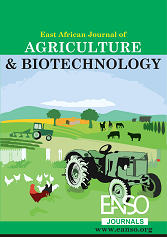Perception and Attitude of Youth on the Use of insects as Food and Feed, Kenya
Abstract
There is no doubt about the nutritional value and environmental impact of edible insects; they are a good substitute for source of protein. However, incorporating them in the human daily diets requires an intense change in mentality of youth in Kenya. People’s attitude towards a food product is important when it comes to its acceptance. Therefore, the aim of the research was to explore the perception and attitude of young people in Kenya on the utilization of insects as food and feed. The findings showed that Kenyan youth have a neutral to a possible positive perception and attitude regarding the use of edible insects as food and feed. The findings of a logistic regression analysis show that education level is associated with low likelihood of consuming and using insects as livestock feed. The perceived benefits, feelings and intentions were also associated with low probability of insects consumption and use as livestock feed. However, 79.9% of respondents were willing to incorporate insects in their food diets and 75.6% were willing to use them as a source of income.
Downloads
References
Alemu, M.H., Olsen, S.B., Vedel, S.E., Pambo, K.O., and Owino, V.O. (2015). Consumer acceptance and willingness to pay for edible insects as food in Kenya: the case of white winged termites, IFRO working paper, No.10. http://hdl.handle.net/10419/204390
Castaneda, A., Doan, D., Nguyen, M.C., Uematsu, H., & Azevedo, J. P. (2016). Who are the poor in the developing world? World Bank Policy Research Working Paper, (7844). http://documents.worldbank.org/curated/en/187011475416542282/Who-are-the-poor-in-the-developing-world
Chia, S. Y., Macharia, J., Diiro, G. M., Kassie, M., Ekesi, S., van Loon, J. J. A., Dicke, M., Tanga, C. M. (2020). Smallholder farmers’ knowledge and willingness to pay for insect-based feeds in Kenya. PLOS ONE, 15 (3). https://doi.org/10.1371/journal.pone.0230552
Domingues, C. H. D. F., Borges, J. A. R., Ruviaro, C. F., Gomes Freire Guldolin, D., & Rosa Mauad Carrijo, J. (2020). Understanding the factors influencing consumer willingness to accept the use of insects to feed poultry, cattle, pigs and fish in Brazil. PL0S ONE, 15(4). https://doi:1371/journal.pone.0224059
FAO (2006). Food security, policy brief, No.2.https://www.fao.org
Gmuer, A., Nuessli, G. J., Hartmann, C., & Siergriest, M. (2016). Effects of the degree of processing of insect ingredients in snacks on expected emotional experiences and willingness to eat. Food Quality and Preference, 54, 117-127. https://doi.org/10.1016/j.foodqual.2016.07.003
Hartmann, C., Jing, S., Alice, G., & Michael, S. (2015). The psychology of eating insects: A cross-cultural comparison between Germany and China. Food Quality and Preference, 44, 148- 156. https://doi.org/10.1016/j.foodqual.2015.04.013
Johnston, R., Jones, K., & Manley, D. (2018). Confounding and collinearity in regression analysis: a cautionary tale and an alternative procedure illustrated by studies of British voting behavior. Qual. Quant., 52(4), 1957-1976. https://doi.org/10.1007/s11135-017-0584-6
Lensvelt, E. J. S., & Steenbekkers, L. P. A. (2014). Exploring Consumer Acceptance of Entomophagy : A Survey and Experiment in Australia and the Netherlands Exploring Consumer Acceptance of Entomophagy : A Survey and Experiment in Australia and the Netherlands. Ecology of Food and Nutrition, 53(5), 543– 561. https://doi.org/10.1080/03670244.2013.879865
Manditsera, F. A., Lakemond, C. M. M., Fogliano, V., Zvidzai, C.J., & Luning, P.A. (2018). Consumption patterns of edible insects in rural and urban areas of Zimbabwe: taste, nutritional value and availability are key elements for keeping the insect eating habit. Food security, 10, 561-570. https://doi.org/10.1007/s12571-018-0801-8
Martins, Y., & Pliner, P. (2006). ‘Ugh! That’s disgusting!’: Identification of the characteristics of foods underlying rejections based on disgust. Appetite, 46, (1), 75-85. https://doi.org/10.1016/j.appet.2005.09.001
Melgar-Lalanne, G., Hernandez-Alvarez, A., & Salinss-Castro, A. (2019). Edible insects processing: Traditional and innovative technologies. Comprehensive reviews in Food Science and Food Safety, 18(4). https://doi.org/10.1111/1541-4339.12463
Min-Harris, C. (2009). Youth Migration and Poverty in Sub-Saharan Africa : Empowering the Rural Youth. Topical review digest: human rights in Sub-Saharan Africa, 59-186. https://www.du.edu>hrhw
Moore, K. (2005). Thinking about youth poverty through the lenses of chronic poverty, life-course poverty and intergenerational poverty. Chronic Poverty Research Centre Working Paper, (57). https://www.chronicpoverty.org>5
Sogari, G., Menozzi, D., & Mora, C. (2017). Exploring young foodies’ knowledge and attitude regarding entomophagy: A qualitative study in Italy. International Journal of Gastronomy and Food Science, 7(2017), 16–19. https://doi.org/10.1016/j.ijgfs.2016.12.002
Steggerda, S. (2015). Consumer attitudes towards edible insects. https://edepot.wur.nl
Tan, H. S. G., Fischer, A. R. H., Tinchan, P., Stieger, M., Steenbekkers, L. P. A., & van Trijp, H. C. M. (2015). Insects as food: Exploring cultural exposure and individual experience as determinants of acceptance. Food Quality and Preference, 42, 78-89. https://doi.org/10.1016/j.foodqual.2015.01.013
United Nations. (2005). Youth in a global Economy, World Youth report. www.un.org
Vaccaro, D, Aderson, K, Clark, L, Gluhosky, E, & Lutch, S. (2019). Inquiries of entomophagy: developing and determining the efficacy of youth-based curriculum. https://scholarworks.umt.edu/uttp/226
Van Huis, A., Itterbeek, J. V., Klunder, H., Mertens, E., Halloran, A., Muir, G., & Vantomme, P. (2013). Edible insects: future prospects for food and feed security (No. 171). Food and agriculture organization of the United Nations. www.fao.org
Verbeke, W. (2015). Profiling consumers who are ready to adopt insects as a meat substitute in a Western society. Food Qual. Pref., 39, 147-155. https://doi.10.1016/j.foodqual.2014.07.008
Wagner, D. L., Grames, E. M., Forister, M. L., Berenbaum, M. R., & Stopak, D. (2021). Insect decline in the Anthropocene: Death by a thousand cuts. Proceedings of the National Academy of Sciences of the United States of America, 118(2). https://doi.org/10.1073/pnas.2023989118
Copyright (c) 2022 Keineetse Emelda Morris, Arnold Onyango Watako, PhD, Walter Akuno, PhD

This work is licensed under a Creative Commons Attribution 4.0 International License.




























